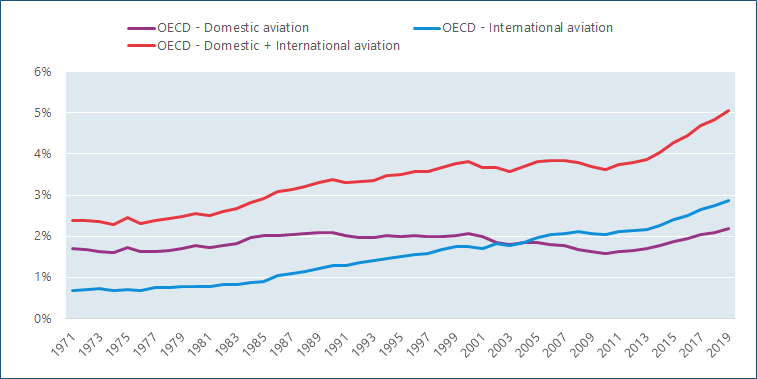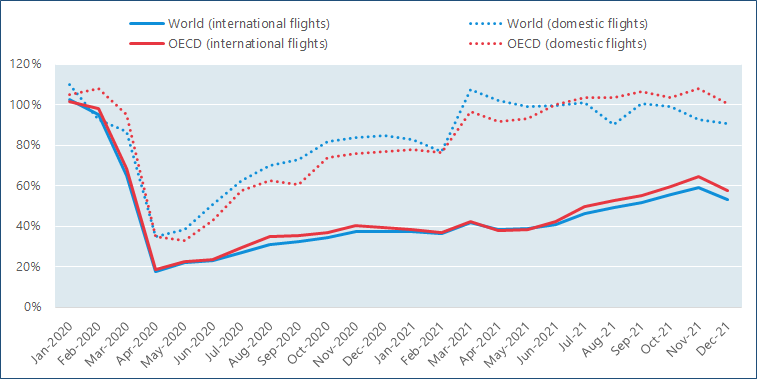National accounts
New OECD database provides timely evidence on CO2 emissions from air transport
14 Mar 2022 - Air transport can move people and goods quickly over large distances and, by facilitating international trade and tourism, it contributes to economic growth and job creation. On the other hand, the aviation industry makes a significant contribution to global CO2 emissions. In 2019, just before the start of the COVID-19 pandemic, CO2 emissions from air transport accounted for 3% of global energy-related CO2 emissions. In absolute values, this was roughly equal to the total energy-related CO2 emissions of Japan. In OECD countries, the share was 5% and was characterised by a rapidly increasing trend driven by increasing flights between countries.
Air transport emissions were increasing before the pandemic
|
The new OECD database
The OECD has developed a database that estimates aviation-related CO2 emissions by using air traffic data from the International Civil Aviation Organization (ICAO) combined with a CO2 emissions calculator from the European Organisation for the Safety of Air Navigation (EUROCONTROL). This new database has close to global coverage and allows us to track emissions on a monthly and near-real-time basis, observing the impact of events like the COVID-19 pandemic almost immediately. Another advantage of the database is that it provides breakdowns into domestic and international flights, and into passenger and freight flights. It even permits granular detail such as the monitoring of specific routes.
Getting the stats quickly is important…
The COVID-19 pandemic demonstrated the value of the new OECD database in providing estimates quickly. The pandemic hit the air transport sector hard. Travel restrictions and concern about the virus decimated passenger air travel. In April-May 2020, CO2 emissions from air transport were 75% lower compared with the same period one year earlier. It took domestic flights almost a year to recover, but in March 2021 CO2 emissions regained their pre-pandemic levels. For international aviation, CO2 emissions were still 45% lower in December 2021 than two years previously, and emissions from all flights (domestic and international) were 30% lower.
Before the development of the new database, we would not have been able to observe these effects until at least a year later. The official Air Emissions Accounts (AEAs) of the System of Environmental Economic Accounting (SEEA) and the UN Framework Convention on Climate Change (UNFCCC) inventories are published at least 12 and 16 months respectively after the end of the reference year - and often with a longer time lag.
Emissions from domestic flights have recovered pre-pandemic levels, while emissions from international flights remain lower
|
… for policy decisions…
Before the COVID-19 pandemic, emissions from air transport were expected to triple between 2015 and 2050. More recent projections by the International Transport Forum predict that without any action to limit CO2 emissions from air transport, they will still increase by two and a half times during this period. Policy action and technological improvements to aircraft are key to curbing the contribution of the aviation industry to global CO2 emissions. The new OECD database will provide policy makers with timely information that will be crucial in tracking the post-pandemic trends in air transport, the impact of developments in aircraft technology and the impact of environmental policies such as carbon taxation schemes.
…and so is the ability to zoom in on the detail
The fact that the OECD database can provide granular detail and breakdowns will be useful for evaluating new policies and technologies affecting CO2 emissions from air transport. Such changes may apply only to certain types of route or types of flight, and the new database is in a unique position to monitor their impact. For example, we could track the effect of a new, more fuel-efficient long-distance airplane on international passenger flights. Or we could observe the impact of a new carbon tax on domestic flights and international flights separately. If carbon taxation and other measures to curb emissions are implemented at different times in different places, differences between countries and over time can be observed. In these ways, the new database will help to assess the impact of policies on CO2 emissions from aviation.
Where to find the underlying data?
Further reading
-
Pionnier, P., et al. (2022), "CO2 Emissions from air transport: A near-real-time global database for policy analysis", OECD Statistics Working Papers, No. 2022/04, OECD Publishing, Paris.
-
OECD Statistical Insight (10/03/2021): "A new near-real-time global database on CO2 emissions from air transport".
Contact
For further information, please contact the OECD Statistics and Data Directorate at stat.contact@oecd.org.
 |
Follow us @OECD_Stat |
Related Documents

